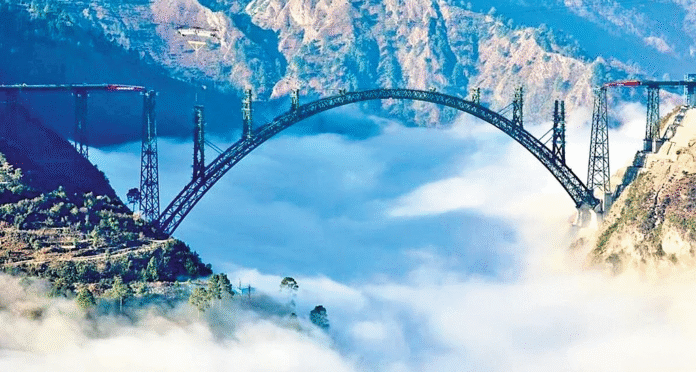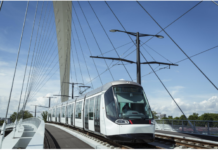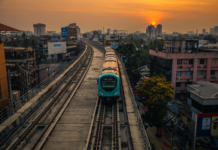Abstract
Indian contribution to the nation has been unparalleled from the beginning. After independence, Indian Railways has played an instrumental role in strengthening and enhancing economic activity and improving connectivity across the country. However, in the post-independence period, the Jammu and Kashmir region remained disconnected from the national mainstream, primarily due to political reasons. As a result, the people of the region had limited access to quality education and employment opportunities, which hindered socio-economic progress and kept the region on the periphery of national development.
The Udhampur–Srinagar–Baramulla Rail Link (USBRL) project stands as one of the most challenging and remarkable railway infrastructure ventures ever undertaken by Indian Railways. The USBRL project spans 272 kilometres. This strategically planned rail corridor connects the Kashmir Valley with the rest of the country. Traversing the formidable Himalayan terrain, the project overcame extremely complex and adverse geological conditions, which outlines engineering excellence. The USBRL project not only exemplifies India’s growing technical capabilities but also reflects the progress the nation has achieved in executing infrastructure projects in some of the world’s most difficult environments.
This paper investigates all the critical aspects of the Udhampur–Srinagar–Baramulla Rail Link project and the hurdles encountered during its implementation. In addition, the study examines the impact of this project on the Kashmir region. The USBRL project doesn’t just strengthen the connectivity; it will be beneficial in multifaceted ways.
The Conceptualisation of the Rail Link to Kashmir:
The Railway Connectivity in the Jammu Region Before 1947- Connecting the Remains
A little-known fact about the Jammu region is that it once had its own dedicated railway line, long before the modern rail network reached the area. Maharaja Pratap Singh, the ruler of the princely state of Jammu and Kashmir, played a key role in introducing rail connectivity to the region. He facilitated the construction of a 43 km (27 mile) broad-gauge railway line between Sialkot (now in Pakistan) and Jammu. This line linked the city with Lahore, which was then the capital of undivided Punjab.
This railway line was an extension of the North Western Railway (NWR) from Suchetgarh in the Sialkot district to Jammu city. It was officially opened for traffic on 13th March 1890. The section from Suchetgarh to Jammu covered approximately 17 miles and served as a critical link for trade, mobility, and administrative connectivity between Jammu and the larger Punjab region during the pre-independence era.
At the time, the train journey from Sialkot to Jammu Tawi took approximately 90 minutes and included scheduled stops at five intermediate stations: Sialkot Cantonment, Suchetgarh, Ranbir Singh Pura, Miran Sahib, and Jammu Cantonment.
In the early 1890s, Maharaja Pratap Singh not only submitted a formal proposal to the British authorities through the Diwan but also directed British engineers to survey the challenging Himalayan terrain for a potential railway route to the Kashmir Valley. He proposed three possible alignments:
- Abbottabad to Srinagar (never realised)
- Jammu to Srinagar line,
- Jammu to Sialkot route
The Jammu to Sialkot Rail Link was discontinued in September 1947 following the suspension of services between India and Pakistan after Partition. As a result, the line was abandoned and gradually fell into disuse and disrepair.
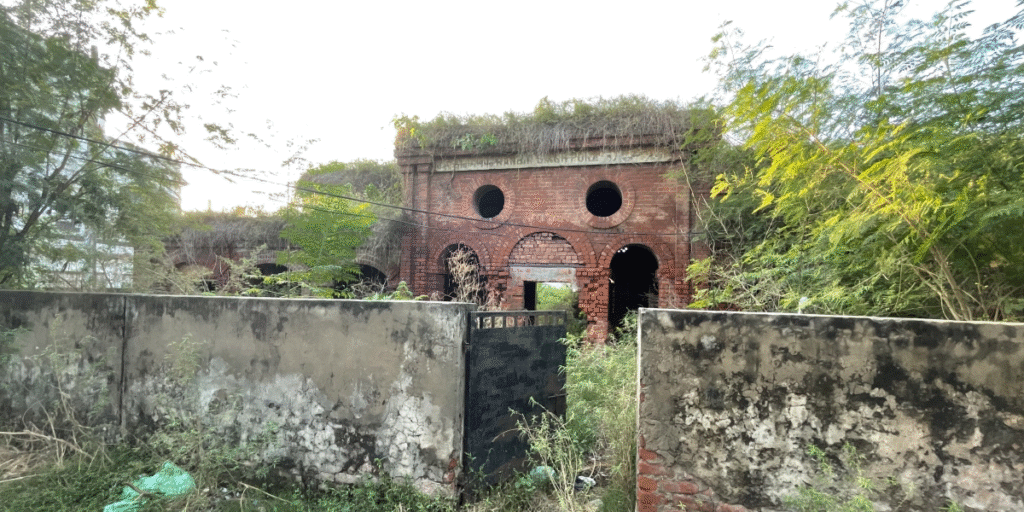
The pre-Partition Ranbir Singh Pura railway station
Post Independence Era:
After 1947, the Jammu & Kashmir region had no rail connectivity and which disconnected the region from the rest of the country. In 1949, efforts were made again to bring Jammu & Kashmir on the railway map by extending the Jalandhar–Mukerian branch line to Pathankot. The construction on this 44km railway line began in November 1949. This line became operational for public use on 7th April, 1952. This line was further extended from Pathankot to Madhopur and then up to Kathua in 1966.
First Train in Jammu after Independence
The vision to reintroduce rail services in the Jammu region materialised in 1969 with the initiation of the project to extend the railway line from Kathua to Jammu. The project holds particular significance as it was executed under challenging circumstances, including the Indo-Pak war of 1971, during which construction work continued without interruption. The line was officially commissioned on 2 October 1972 by then Prime Minister Indira Gandhi.
The Srinagar Express (later renamed the Jhelum Express) became the first train to enter the Jammu region post-independence. It brought Jammu back onto the railway map after a gap of 25 years.
In 1981, the Government of India proposed extending the railway line from Jammu to Udhampur to improve connectivity within the Jammu region. The foundation stone for the project was laid by Prime Minister Indira Gandhi on 14th April 1983. However, due to various delays, construction began only in 1995. After prolonged execution, the 53 km-long Jammu–Udhampur section was finally commissioned in 2005, 21 years after the project’s formal initiation.
The Udhampur-Srinagar-Baramula Rail Link
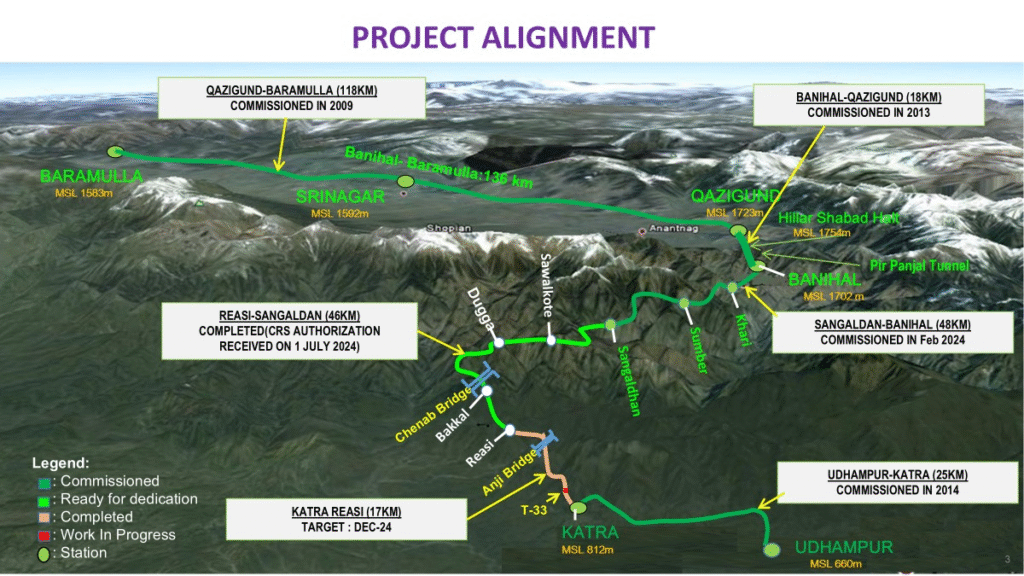
In 1981, the Government of India proposed extending the railway line from Jammu to Udhampur to improve connectivity within the Jammu region. The foundation stone for the project was laid by Prime Minister Indira Gandhi on 14th April 1983. However, due to various delays, construction began only in 1995. After prolonged execution, the 53 km-long Jammu–Udhampur section was finally commissioned in 2005, 21 years after the project’s formal initiation.
While the Jammu–Udhampur railway line was still under construction, the Government of India, in 1994, announced plans to further extend the line from Udhampur to Baramulla via Srinagar. This led to the beginning of what would later become the Udhampur– Baramulla Rail Link (USBRL) project.
The 272 km Udhampur–Srinagar–Baramulla Rail Link (USBRL) project received official approval from the central government in 1995, with an initial estimated cost of ₹2,500 crore. However, due to the project’s complex terrain, engineering challenges, and time overruns, the total project cost has escalated to ₹43,780 crore. In recognition of its strategic importance and scale, the USBRL project was declared a national project in 2002.
Salient Features of the Udhampur-Srinagar-Baramula Project
| Length | 272 km |
| Completion Cost | ₹ 43,780 crore |
| Total Tunnels | 36 (119km) |
| Bridges | 943 |
Engineering Marvels | Chenab Bridge (World’s Highest Rail Bridge) |
| Anji Khad Bridge (India’s first cable-stayed railway bridge) | |
| T-50 (India’s Longest Tunnel-12.775 km) |
The Implementation of the USBRL Project in Phases
The Udhampur–Srinagar–Baramulla Rail Link (USBRL) project has been implemented in phases over the years. The project has been divided into three main sections:
To facilitate execution, the project is further broken down into the following legs:
Leg 1: Udhampur–Katra (25 km)
- Katra – Chak Rakhwal
- Chak Rakhwal – Udhampur
Leg 2: Katra–Banihal (111 km)
- Katra – Reasi
- Reasi – Sangaldan
- Sangaldan – Banihal
Leg 3: Banihal–Baramulla (136 km)
- Banihal – Qazigund
- Qazigund – Anantnag
- Anantnag – Mazhom
- Mazhom – Baramulla
- Qazigund-Baramulla Rail Link (2009): This 119km section lies entirely within the Kashmir Valley, surrounded by mountain ranges on all sides. The final segment of this line was inaugurated on 28 October 2009 by then Prime Minister Dr. Manmohan Singh, which began rail connectivity within the valley.
Commissioning Timeline of Qazigund-Baramulla Rail Link
| 11 October 2008 | Anantnag – Mazhom | 66km |
| 14 February 2009 | Mazhom – Baramulla | 35km |
| 28 October 2009 | Quazigund – Anantnag | 18km |
- Qazigund- Banihal Rail Link (2013):
TThe Qazigund–Banihal section, a vital 18 km stretch of the Udhampur–Srinagar–Baramulla Rail Link (USBRL) project, was inaugurated on 26 June 2013 by then Prime Minister Dr. Manmohan Singh. This segment includes the 11.2 km-long Pir Panjal Tunnel, one of the longest railway tunnels in India. The construction of this section was executed by IRCON International at an estimated cost of ₹1,672 crore.

- Udhampur- Katra Section (2014)
The 25.6 km Katra–Udhampur railway line was inaugurated on 4 July 2014 and developed at an estimated cost of ₹1,132.75 crore. The route comprises two segments:
- 15.5 km between Katra and Chak Rakhwal,
- 9.4 km between Chak Rakhwal and Udhampur
This route connects the Reasi and Udhampur districts. This section passes through hilly terrain within the Shivalik and Trikuta ranges, featuring complex geological conditions and elevation changes. Engineering works on this stretch include 10.9 km of tunnels.

The section plays a functional role in regional connectivity and forms a part of the larger Udhampur–Srinagar–Baramulla Rail Link (USBRL) project.

First Passenger Train from Udhampur to Katra
- Katra–Banihal Section:
This section of the USBRL project encountered some of the most complex engineering challenges, primarily due to unstable geological conditions, unpredictable terrain. The alignment traverses a young mountainous fault region and a thrust fault zone within a seismically active Himalayan environment, adding to the construction difficulties.
One of the most demanding components along the Katra–Banihal stretch is the Chenab Bridge, designed to cross the Chenab River Gorge at a height of 359 meters above the riverbed. With a total length of 1,355 meters and a main arch span of 467 meters, it stands as one of the tallest railway bridges in the world.
Another engineering feat is the Anji Khad Bridge, constructed to span a deep gorge of approximately 330 meters. A cable-stayed design was adopted for this bridge, which makes it the first instance of such a structure being used in Indian Railways.
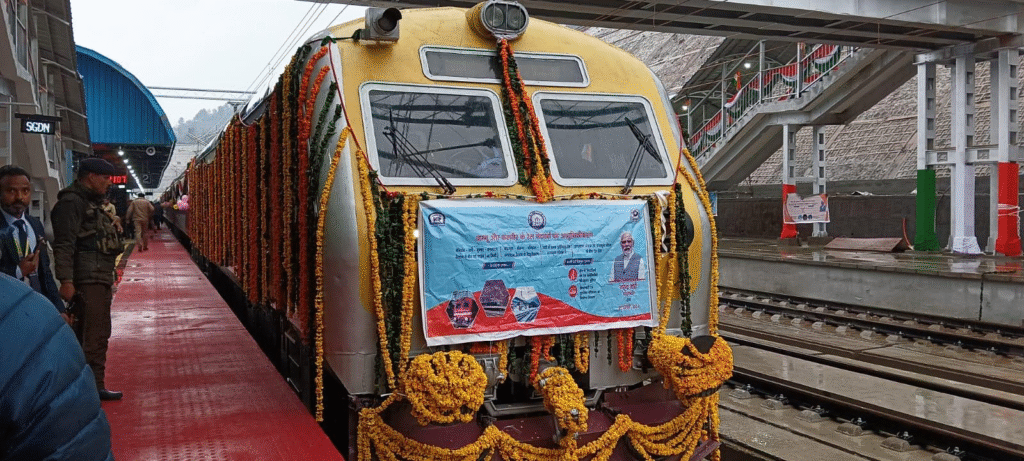
- Sangaldan- Banihal section: The 48km section connecting Sangaldan and Banihal became the first leg to become operational on the Katra Banihal section of the USBRL project. This line was inaugurated on 20 February 2024 by Prime Minister Narendra Modi.
- Sangaldan-Reasi section: The work on this 46 km section was completed in June 2024.
- Reasi Katra section: This 17km section was completed in December 2024
First Trial on Katra-Banihal Section: After years of waiting, Indian Railways conducted the first successful trial run on the Banihal–Katra railway section on January 4, 2025.
Inauguration of USBRL Project: Prime Minister Narendra Modi inaugurated the Udhampur-Srinagar-Baramulla Rail Link (USBRL) on 6 June 2025.
Engineering Marvels on India’s Most Challenging Railway Route
Chenab Rail Bridge

The Chenab Rail Bridge, part of the Udhampur–Srinagar–Baramulla Rail Link (USBRL) project, stands as a major engineering accomplishment in the history of Indian infrastructure. The Chenab bridge stands at a height of 359 metres above the riverbed. It is the world’s highest railway arch bridge, exceeding the height of the Eiffel Tower. The total length of the bridge is 1,315 metres, and it plays a crucial role in connecting Jammu with the Kashmir Valley.
The bridge is constructed at an estimated cost of ₹1,486 crore, the bridge is designed to withstand extreme terrain and climatic conditions. It can endure wind speeds up to 260 km/h and is built to last 120 years. Engineers used advanced tools like Tekla software for structural detailing, which enabled them to model and execute the bridge with high precision.
Anji Khad Bridge
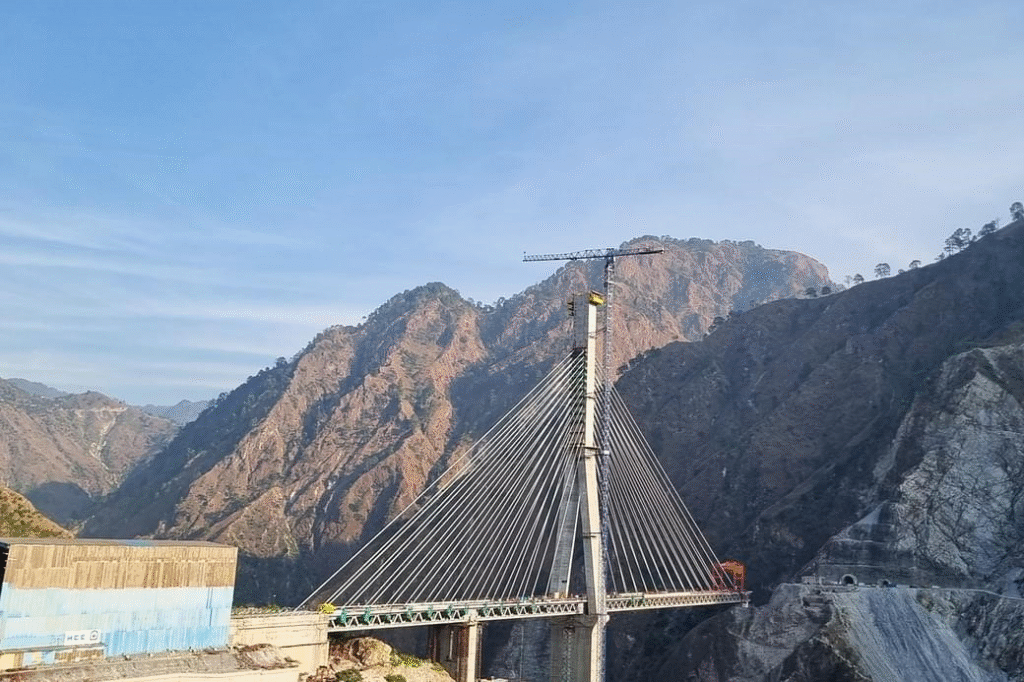
The Anji Khad Bridge, located on the Katra–Reasi section of the USBRL project, is situated approximately 80 kilometres from Jammu. The bridge stretches 725 metres in length and soars 331 metres above the riverbed, which makes it one of the tallest railway bridges in the region. At its core is an inverted Y-shaped pylon that rises 193 metres from the foundation, supporting the main span with the help of 96 high-tensile stay cables.
The bridge’s construction involved approximately 653 kilometres of cable strands and over 8,200 metric tonnes of structural steel, built to withstand the complex geological conditions of the area, including seismic activity and strong winds. The bridge construction took only 11 months to complete.
Tunnel T-50: India’s Longest Transportation Tunnel

Tunnel T-50 is India’s longest transportation tunnel, and it lies in the Sumber–Khari section of the USBRL project. The tunnel stretches 12.77 km, and it includes a Main Tunnel (MT) for rail operations and a parallel Escape Tunnel (ET) to ensure safety and support emergency evacuations. The construction team used the New Austrian Tunnelling Method (NATM) to excavate the tunnel through challenging geological formations.
The South Portal opens in the scenic Sumber Valley, near Sumber village, while the North Portal is located near Arpinchala village in the Mahu-Mangat Valley, Ramban district. The tunnel’s completion highlights a major engineering accomplishment in one of India’s most geologically complex regions.
The Impact of the USBRL Project
Employment: During the construction phase of USBRL, project executing agencies provided employment to 14,069 individuals, with approximately 65% of these opportunities allocated to local residents of Jammu & Kashmir. Additionally, the project has generated over 525 lakh man-days of employment. The commissioning of the project will further create employment in the Kashmir Valley.
Connectivity and Regional Integration: The Udhampur–Srinagar–Baramulla Rail Link (USBRL) project holds strategic importance as it reestablishes rail connectivity between the Union Territory of Jammu & Kashmir and the rest of India. This rail corridor enhances both passenger and freight movement and improves accessibility to remote areas. The improved rail connectivity is expected to facilitate growth in tourism by providing easier access to important pilgrimage destinations such as the Amarnath Cave Temple, Hazratbal Shrine, and Charar-e-Sharif. This is likely to result in increased footfall from devotees and tourists alike, which will contribute to the local economy through greater demand for hospitality, transport, and ancillary services, including hotels, restaurants, and retail establishments. Beyond tourism, the railway line enables more efficient goods transportation, which is important for trade and supply chains across the region.
Push for Economic Activities
- Local Businesses: The establishment of this rail line clears the path to the national market for local businesses, particularly those engaged in agriculture, handicrafts, and local products. The connectivity to national markets is expected to drive revenue growth by enabling wider distribution of products.
- Ecosystem for new Industries: The improved rail connectivity strengthens the logistical efficiency for the movement of raw materials and finished products. The smoother movement of freight will create favourable conditions for the development of industries in sectors such as manufacturing, agriculture, and technology. This improvement in the supply chain is expected to facilitate the expansion of medium-sized enterprises (SMEs).
Strategic and Security Implications:
The USBRL project also has importance from the perspective of national security. In addition to enabling the movement of passengers and goods, the connectivity enhances the operational preparedness of security forces and enhances the region’s strategic accessibility. It also adds to long-term stability by improving administrative reach and infrastructure growth in remote regions.
Conclusion
The completion of the Udhampur–Srinagar–Baramulla Rail Link (USBRL) reflects a major development in the history of Indian Railways. Developed through complex terrain using tunnels, bridges, and modern construction techniques, the project has established all-weather rail access to the Kashmir Valley. It enables more efficient movement of goods and passengers, supports local economic activities, and improves access to essential services. The project features engineering marvels like the Chenab Bridge (the world’s highest railway bridge), the Anji Bridge, and India’s longest transport tunnel. It represents a holistic approach to streamlining economic activity, promoting tourism, and improving the overall quality of life in the Jammu & Kashmir region.


